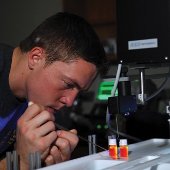John Durocher, a research assistant professor and postdoctoral fellow in Exercise Science, and Huan Yang, a PhD candidate in Exercise Science through the Biological Sciences graduate program, have received the 2011 Caroline tum Suden/Frances Hellebrandt Professional Opportunity Awards from the American Physiological Society.
More than 140 graduate students and postdoctoral fellows throughout the US and beyond applied for the award this year. Only 38 awardees were selected, based on abstracts of their research.
“It is remarkable that both received this abstract-based award, and it is a credit to their hard work, dedication and high caliber of research,” said Dean Bruce Seely (CSA). “Most of the recipients are trainees at medical colleges throughout the US, making this even more remarkable.”
Durocher and Yang will be honored at the 2011 Experimental Biology conference in Washington, DC, this April.
Published by Jennifer Donovan, director of public relations
